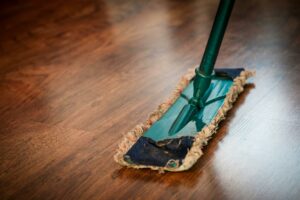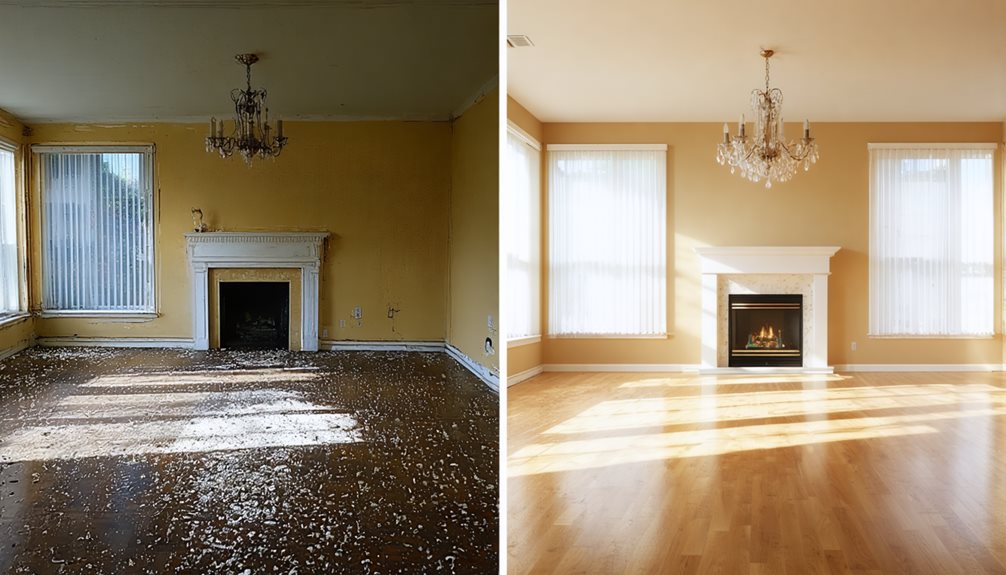Basic vs. Deep Clean
Regular cleaning and deep cleaning serve distinct purposes in maintaining a healthy home. Regular cleaning involves routine tasks like vacuuming, mopping, and surface wiping, typically performed weekly or bi-weekly to maintain baseline cleanliness. Deep cleaning, recommended every 6-12 months, is more comprehensive and targets neglected areas, built-up grime, and hidden contaminants. While regular cleaning costs less and takes 2-3 hours, deep cleaning requires a full day and ranges from $440-$1,300. Your choice depends on specific situations: regular cleaning for ongoing maintenance, deep cleaning for move-ins/outs or establishing initial cleanliness. The following sections investigate the detailed protocols and health benefits of each approach.
Key Takeaways
- Basic cleaning involves routine tasks like sweeping and mopping, while deep cleaning targets hidden areas and accumulated grime.
- Regular cleaning takes 2-3 hours and occurs weekly/monthly, whereas deep cleaning requires 6-8 hours and happens every 6-12 months.
- Deep cleaning costs significantly more ($440-$1,300) but provides thorough sanitization, while basic cleaning maintains everyday cleanliness affordably.
- Choose deep cleaning for move-ins/move-outs, special occasions, or initial cleaning services; basic cleaning works for routine maintenance.
- Deep cleaning improves indoor air quality and eliminates bacteria, while regular cleaning prevents dirt buildup and maintains basic hygiene.
Understanding Regular Cleaning Services
Regular cleaning services constitute the fundamental maintenance approach to keeping living spaces consistently clean and hygienic. These services establish and maintain a baseline level of cleanliness through systematic execution of routine tasks, typically performed on weekly, bi-weekly, or monthly schedules. The primary focus remains on addressing visible areas and maintaining standard cleanliness protocols throughout the space.
The scope of regular cleaning services encompasses essential activities such as sweeping, mopping, and vacuuming floors, alongside systematic surface wiping and dusting. Critical components include disinfecting bathrooms, emptying trash receptacles, and addressing vent surfaces to minimize allergen accumulation. While these services effectively maintain day-to-day cleanliness, they do not extend to neglected spots or areas requiring specialized attention.
As a cost-effective option for ongoing maintenance, regular cleaning proves instrumental in preventing the accumulation of dirt and maintaining consistent hygiene standards. This approach prioritizes frequent, systematic cleaning of commonly used areas, though it differs from deep cleaning in its depth and intensity. The focus remains on maintaining rather than transforming the cleanliness level of the space.
Deep Cleaning Defined
Deep cleaning improves the standard of cleanliness by employing a meticulous, comprehensive approach that addresses both visible and hidden areas within a space. Unlike regular cleaning routines, a deep cleaning service focuses on achieving a certain level of cleanliness that penetrates beyond surface-level maintenance, targeting neglected and hard-to-reach spots that accumulate dirt and bacteria over time.
This intensive cleaning process typically requires significant time investment, often necessitating a full day to complete depending on the space’s dimensions. The thoroughness of deep cleaning encompasses detailed sanitization of interior appliance components, comprehensive dust removal, and overall sanitation of areas frequently overlooked during routine cleaning sessions. The attention to detail characteristic of deep cleaning serves to improve overall livability by eliminating accumulated allergens, persistent grime, and harmful bacteria.
Professional cleaning experts recommend scheduling deep cleaning sessions every six to twelve months, with additional sessions warranted during significant transitions such as residential moves, property sales, or major events. This systematic approach to comprehensive cleaning maintains peak hygiene levels and guarantees long-term preservation of living spaces, making it an essential component of professional cleaning maintenance.
When Each Service Works Best
Regular cleaning services are ideal for maintaining day-to-day cleanliness through scheduled weekly or bi-weekly visits, addressing routine household messes and surface-level dirt accumulation. Deep cleaning services are most appropriate for significant transitions such as move-in or move-out situations, first-time cleaning appointments, or when preparing a home for sale. Special occasions like holiday gatherings or seasonal changes also warrant deep cleaning to guarantee thorough sanitization and improved presentation of living spaces.
Daily Vs Special Occasions
When should you opt for basic cleaning versus a comprehensive deep clean? The decision largely depends on your specific circumstances and cleaning objectives. Regular home cleaning serves as the foundation of household maintenance, while deep cleaning guarantees a more thorough approach for special situations.
- Regular cleaning maintains daily hygiene through weekly or bi-weekly sessions, focusing on frequently used spaces and common areas
- Deep cleaning services are ideal for special events, moving changes, and seasonal refreshes
- Professional cleaners recommend scheduling deep cleans every 6-12 months to address accumulated grime
- First-time clients should start with a deep clean to establish a baseline before moving on to regular maintenance
- Special occasions like holiday gatherings require the level of detail that deep cleaning provides
The main purpose of regular cleaning is to maintain day-to-day cleanliness, while spring cleaning and deep cleaning target neglected areas and provide comprehensive sanitization. The distinction in timing is clear: regular cleaning follows a consistent schedule, whereas deep cleaning aligns with specific events or periodic maintenance needs. This systematic approach guarantees both immediate cleanliness and long-term home care.
Move-In or Move-Out
Moving shifts require specific cleaning approaches to guarantee ideal results for both departing and arriving residents. Deep cleaning stands as the best choice for both move-in and move-out scenarios, addressing comprehensive sanitation needs that regular cleaning cannot fulfill.
Move-in cleaning focuses on eliminating hidden contaminants and allergens left by previous occupants, establishing a healthy living environment for new residents. Conversely, move-out cleaning serves a dual purpose: ensuring the return of security deposits and preparing the space for incoming tenants. Cleaning companies typically mandate an initial service requirement of deep cleaning for first-time clients, establishing a baseline cleanliness standard before shifting to regular cleaning schedules.
Time and cost considerations differ significantly between basic and deep cleaning services during moves. Move-related deep cleaning demands more extensive labor and attention to detail, resulting in higher costs compared to regular maintenance cleaning. For property sellers, investing in deep cleaning before listing can substantially boost market appeal. This strategic approach not only improves visual presentation but also demonstrates meticulous property maintenance, potentially influencing buyer decisions and property valuation.
Room By Room Breakdown
Deep cleaning a kitchen requires thorough attention to built-up grime inside appliances like ovens and refrigerators, along with cleaning behind these fixtures to address often-neglected areas. In bathrooms, comprehensive cleaning involves detailed scrubbing of grout lines, thorough sanitization of vanity interiors, and removal of accumulated soap scum that can lead to mold growth. These intensive cleaning processes, while more time-consuming than regular maintenance, are essential for maintaining ideal hygiene standards and preventing long-term deterioration of surfaces in these high-traffic spaces.
Kitchen Deep Clean Essentials
The essentials of a thorough kitchen deep clean extend far beyond typical daily maintenance, encompassing critical areas that often escape routine attention. Professional deep cleaning involves comprehensive sanitization of high-touch areas, including stove knobs and sink handles, which are primary vectors for bacterial transmission. Regular cleaning practices must be supplemented with intensive efforts to maintain superior kitchen hygiene and reduce foodborne illness risks.
Key components of a comprehensive kitchen deep clean include:
- Moving and cleaning behind major appliances to address hidden dirt accumulation
- Thorough interior sanitization of refrigerators and ovens, with monthly refrigerator maintenance
- Detailed cleaning of cabinet surfaces and decorative elements to eliminate dust and allergens
- Focused attention on high-touch areas to minimize bacterial spread
- Complete sanitization of cooking zones and food preparation surfaces
This methodical approach guarantees the elimination of hidden contaminants that standard cleaning might miss. The process requires accessing typically overlooked spaces and implementing professional-grade cleaning techniques for appliance interiors. By addressing these essential areas, a deep clean creates a safer, more hygienic cooking environment while extending the lifespan of kitchen components through proper maintenance.
Bathroom Detail Breakdown
Bathroom maintenance requirements demonstrate a clear distinction between regular cleaning practices and comprehensive deep cleaning protocols. While regular cleaning focuses on visible surface maintenance and routine disinfecting of high-touch areas, deep cleaning encompasses a more thorough approach to sanitization and preventive care.
Regular cleaning tasks typically involve wiping down sinks, countertops, and basic surface dusting. However, deep cleaning your kitchen principles extend to bathroom care, where specialized attention targets neglected areas such as grout lines, soap scum accumulation, and interior cabinet spaces. High-germ areas, particularly toilet bases and surrounding zones, require intensive disinfecting to prevent bacteria proliferation during deep cleaning sessions.
To maintain ideal bathroom hygiene, experts recommend implementing a deep cleaning regimen every three months, complementing regular maintenance routines. This systematic approach effectively addresses hidden contaminants that routine cleaning might miss, including mold and mildew formation in less visible areas. The comprehensive nature of deep cleaning extends to often-overlooked elements like wastebaskets and medicine cabinet interiors, ensuring a thoroughly sanitized environment that surpasses standard cleaning protocols.
Cost Comparison and Value
Professional cleaning services present distinct cost variations between basic and deep cleaning options, with deep cleaning services ranging from $440 to $1,300 depending on property size. The cost differential reflects the comprehensive nature of deep cleaning, which encompasses all regular cleaning tasks plus intensive attention to neglected areas. Regular cleaning typically requires 2-3 hours, while deep cleaning can occupy an entire day due to its thorough approach.
- Deep cleaning delivers comprehensive sanitization and detailed attention to often-overlooked areas
- Regular cleaning maintains cleanliness through routine upkeep at a lower cost point
- Time investment varies significantly: regular cleaning (2-3 hours) vs. deep cleaning (full day)
- Scheduling regular cleaning reduces long-term costs by preventing deep cleaning needs
- Deep cleaning improves both hygiene standards and overall property livability
When evaluating the cost comparison between services, consider that investing in deep cleaning provides substantial value through thorough sanitization and restoration of spaces. However, implementing a regular cleaning schedule proves more cost-effective for ongoing maintenance. The cleaning company’s expertise determines which service best matches your house needs. Spring cleaning often requires deep cleaning, but maintaining regular cleaning schedules can minimize the frequency of extensive cleaning sessions.
Time Investment for Each Type
Scheduling professional cleaning services requires a clear understanding of the time commitments involved for each type of service. Regular house cleaning typically demands 2-3 hours of focused attention, encompassing essential maintenance tasks that maintain a certain level of cleanliness through routine activities like vacuuming and dusting. This time-efficient approach makes it feasible to schedule on a weekly or bi-weekly basis.
The difference between deep cleaning and regular maintenance becomes evident in the time investment required. A professional house cleaning service performing a deep clean will typically need 6-8 hours or more, depending on the property size. Deep cleaning encompasses all standard cleaning tasks plus intensive detail work in often-neglected areas, making it a significantly more time-consuming process. While regular cleaning focuses on maintaining cleanliness through consistent upkeep, when you schedule a deep clean, you’re committing to a comprehensive service that often requires an entire day to complete properly. Industry professionals recommend scheduling deep cleaning services every 6-12 months, complementing regular maintenance cleaning to achieve peak results in maintaining a pristine living environment.

Health Benefits and Considerations
A pristine living environment extends far beyond mere aesthetics, delivering substantial health benefits through both basic and deep cleaning practices. While regular cleaning maintains a baseline of hygiene, deep cleaning provides comprehensive health advantages by targeting often-overlooked areas where contaminants accumulate.
- Deep cleaning significantly improves indoor air quality by removing embedded allergens and microscopic particles that basic cleaning might miss
- Professional-grade sanitation processes eliminate bacteria concentrations around high-touch surfaces and hidden corners
- Thorough cleaning prevents mold and mildew growth in moisture-prone areas, reducing respiratory health risks
- Improved cleanliness contributes to enhanced mental well-being and reduced stress levels
- Regular deep cleaning maintenance can result in long-term health cost savings
The impact of deep cleaning on occupant health is particularly significant in its ability to eliminate harmful microorganisms and allergens that accumulate over time. Scientific studies consistently demonstrate that environments subjected to periodic deep cleaning show markedly reduced levels of harmful bacteria and respiratory irritants. When implemented on a semi-annual or annual basis, deep cleaning protocols create a significantly healthier living space compared to basic cleaning alone, offering both immediate and long-term health benefits for occupants.
Making The Right Choice
Determining whether to opt for basic or deep cleaning services requires careful consideration of multiple household factors and specific circumstances. The standard rule suggests maintaining regular cleaning on a weekly or bi-weekly basis, while scheduling deep cleaning every 6-12 months for ideal home maintenance.
Specific situations clearly indicate when you need a deep cleaning service over regular maintenance. Moving into or vacating a property necessitates comprehensive cleaning tasks included in deep cleaning packages. Homes with pets or high foot traffic areas may require more frequent deep cleaning sessions, potentially every 3-4 months, to address accumulated allergens and bacteria that standard cleaning might not eliminate. Professional house cleaning services should be engaged before significant events or gatherings to guarantee thorough sanitization and presentation.
The decision between regular and deep cleaning should align with your household’s unique requirements. Consider factors such as the presence of children, pets, allergies, and overall occupancy levels. This systematic evaluation helps determine the appropriate cleaning schedule and type of service needed to maintain a healthy living environment while maximizing resources and guaranteeing effective results.
Frequently Asked Questions
Can I Get a Regular Cleaning if I Need a Deep Cleaning?
While it’s technically possible to request a regular cleaning service, it’s not recommended if your space requires deep cleaning. Regular cleaning maintains already-clean spaces but won’t address accumulated grime, deep-seated dirt, or extensive sanitization needs. Professional cleaning services typically recommend starting with a deep cleaning to establish proper cleanliness baselines before shifting to regular maintenance services. This guarantees ideal results and long-term cleanliness standards.
What Is the Difference Between Basic Teeth Cleaning and Deep Cleaning?
Like comparing a gentle spring shower to a power washer, basic teeth cleaning and deep cleaning serve distinctly different purposes. Basic cleaning (prophylaxis) focuses on removing plaque and tartar from visible tooth surfaces during routine 30-minute appointments. In contrast, deep cleaning (scaling and root planing) is a comprehensive procedure that extends below the gum line, targeting bacterial buildup on root surfaces, typically requiring 1-2 hours and costing significantly more per quadrant.
What Is Typically Included in a Deep Clean?
A deep clean encompasses comprehensive sanitization and detailed attention to typically neglected areas. This includes thorough cleaning behind and underneath appliances, interior cleaning of ovens and refrigerators, sanitizing grout lines, and eliminating soap scum and limescale from fixtures. The service also involves upholstery cleaning, vacuuming beneath furniture, and addressing high-reach areas such as light fixtures, baseboards, and ceiling corners. All surfaces receive intensive disinfection and detailed scrubbing.
What Does a Basic Clean Involve?
“A stitch in time saves nine” perfectly captures the essence of basic cleaning – regular maintenance prevents bigger issues. A basic clean encompasses routine tasks focused on maintaining day-to-day cleanliness. This service typically includes vacuuming and mopping floors, dusting surfaces and fixtures, bathroom sanitization including toilets and sinks, and kitchen maintenance such as wiping countertops and removing trash. These standard procedures are performed on a recurring schedule to maintain baseline cleanliness.





